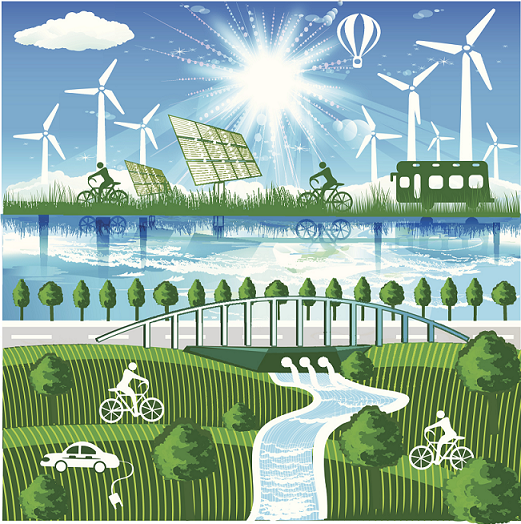Energy and the Environment Research
 The energy choices we make as a society influence our air and water quality and water supply, among other impacts. In an evolving energy landscape, how do we make sustainable energy decisions that balance environmental, economic, and societal objectives?
The energy choices we make as a society influence our air and water quality and water supply, among other impacts. In an evolving energy landscape, how do we make sustainable energy decisions that balance environmental, economic, and societal objectives?
Researchers are studying the potential health and environmental impacts of using different energy sources. The goals include:
- Evaluate the impacts of changes in the energy system to climate and air quality.
- Assess the impacts of air quality on biomass as an energy source.
- Identify and analyze models and approaches to assist with understanding impacts of emerging energy technologies and resources.
The research will improve the ability of the nation to evaluate the potential costs, benefits and risks associated with production and use of emerging energy resources.
On this page:
Energy Systems Modeling
The nation’s energy system, which is the mix of technologies that produce and use energy, is undergoing rapid transformation. For example, since 2010, there has been a considerable shift in how electricity is produced, with much greater shares being met by natural gas, wind, and solar power. In buildings, incandescent lighting is rapidly being replaced by CFL (compact fluorescent) and LED (light-emitting diode) bulbs. In transportation, we are seeing major year-to-year increases in market share of electric vehicles. And other technologies, such as fuel cells, offshore wind power, home battery storage, and automated vehicles are becoming more practical and affordable.
As emerging technologies increase market share, there can be significant impacts—either positive or negative—on air quality, water consumption, waste generation, and other environmental endpoints. It is important that consumers understand and consider the impacts of their energy choices. Similarly, this information can benefit regional, state, and local governments as they adopt policies and incentivize technologies to meet environmental and energy goals.
Quantifying the value of new and emerging technologies requires taking a holistic approach that includes both their impacts and those of the technologies that are displaced. Energy system models provide a way to do that. These models simulate the supply and demand for energy over time, predicting the market share of competing technologies and fuels, as well as the resulting emissions and water use. On the supply side, these models represent energy production, electricity generation and refining. On the demand side, they include end uses such as passenger travel, lighting, space heating and manufacturing.
With considerable uncertainty about the future, a strength of these models is that they allow users to evaluate alternative scenarios. For example, these scenarios could involve different assumptions about population growth and migration, economic growth and transformation, climate change, technology development, behavior, and environmental and energy policies.
These energy modeling frameworks allow users to explore the potential energy, emissions and environmental consequences of “What if…?” scenarios, such as:
- What if electric vehicles achieve a 50% market share of the new car sales?
- What if oil prices are more stable over the coming decades?
- What if offshore wind achieves energy prices that are comparable to natural gas combined cycle turbines?
The frameworks also support “How can I?” questions, such as, “How can I reduce pollutant emissions by 50%?” Energy models can identify cost effective strategies for answering that question. Researchers at EPA are developing and using energy modeling frameworks to ask these and other questions about the future of energy and potential impacts on the environment.
The objectives of EPA’s work in energy system modeling include:
- Identifying challenges to improving and maintaining air quality.
- Projecting future emissions outputs for various technology and policy scenarios.
- Identifying cost-effective strategies for meeting air quality targets.
- Developing and disseminating tools that bring these capabilities to researchers and state decision makers.
Key Tools for Energy System Modeling at the EPA
 Three tools developed by researchers are providing the ability to more fully understand the impacts of energy production and use, from city to regional and national scales.
Three tools developed by researchers are providing the ability to more fully understand the impacts of energy production and use, from city to regional and national scales.
- COMET (City-based Optimization Model for Energy Technologies) is an energy-environment-economic optimization model designed to capture the whole energy system at the city level. COMET provides long-term prospects for practical and applicable energy policy solutions, especially for cities that aim to achieve emissions reduction targets.
- EPAUS9rT - An Energy Systems Database for use with the TIMES Model -- The EPAUS9rT is a regional database representation of the United States energy system developed for use with the TIMES model. TIMES is an energy system optimization model used by local and federal governments, national and international communities and academia. EPAUS9rT represents energy supply, technology and demand throughout the major sectors of the U.S. energy system.
- GLIMPSE -- GLIMPSE is a decision support modeling tool that will assist states with energy and environmental planning through the year 2050. Users of GLIMPSE can explore the impacts of energy technologies and policies on the environment.
Related Links:
Biofuels and the Environment
 The 2007 Energy Independence and Security Act (EISA) was enacted to provide “greater energy independence and security [and] to increase the production of clean renewable fuels.” Part of EISA requires EPA to revise its Renewable Fuel Standard (RFS) program to achieve substantial increases in the volume of biofuels used in the nation’s transportation fuels. EISA and the RFS set goals of up to 36 billion gallons per year of biofuel use by 2022. Although combined production of ethanol and biodiesel was less than 18 billion gallons in 2019, it is more than twice the volume produced in 2007 when EISA was passed.
The 2007 Energy Independence and Security Act (EISA) was enacted to provide “greater energy independence and security [and] to increase the production of clean renewable fuels.” Part of EISA requires EPA to revise its Renewable Fuel Standard (RFS) program to achieve substantial increases in the volume of biofuels used in the nation’s transportation fuels. EISA and the RFS set goals of up to 36 billion gallons per year of biofuel use by 2022. Although combined production of ethanol and biodiesel was less than 18 billion gallons in 2019, it is more than twice the volume produced in 2007 when EISA was passed.
Biofuels are fuels derived from renewable biological materials. Ethanol and biodiesel are currently the most widely used biofuels in the U.S. Ethanol derived from corn starch is the most widely used biofuel in the U.S. Most vehicles can use gasoline-ethanol blends containing up to 10% ethanol (by volume). Flexible fuel vehicles can use blends containing up to 85% ethanol. Biodiesel is made from oilseed crops (soybean, sunflower, rapeseed) and waste fats, oils, and greases. Most biodiesel in the U.S. is produced from soybean oil. Biodiesel is most often blended with petroleum diesel in ratios of 2% (referred to as B2), 5% (B5), or 20% (B20).
EISA recognizes that the increased production and use of biofuels could have impacts on the environment and natural resources. Therefore, the Act requires EPA to report to Congress every three years on the environmental and resource conservation impacts of the increased production and use of biofuels. EISA specifically requires EPA to report on the following:
- Environmental issues, including air quality, effects on hypoxia, pesticides, sediment, nutrient and pathogen levels in waters, acreage and function of waters, and soil environmental quality.
- Resource conservation issues, including soil conservation, water availability, and ecosystem health and biodiversity, including impacts on forests, grasslands, and wetlands.
- The growth and use of cultivated invasive or noxious plants and their impacts on the environment and agriculture.
The reports are also required to discuss biofuel and biofuel feedstocks and the environmental impacts outside the United States of producing those fuels and feedstocks consumed in the U.S.
EPA’s Office of Research and Development leads the development of the reports to Congress, working with EPA’s Office of Air and Radiation and consulting with experts from the U.S. Department of Agriculture and the U.S. Department of Energy. EPA has published two reports. The Third Triennial Report to Congress is under development and scheduled to be provided to Congress in 2021.
Related Links:
- Biofuels and the Environment: the First Triennial Report To Congress. The first report to Congress was completed in 2011 and provided an assessment of the environmental and resource conservation impacts associated with increased biofuel production and use.
- Biofuels and the Environment: Second Triennial Report to Congress. The Second Triennial Report to Congress was completed in 2018. This report reflects the current scientific understanding of the impacts as presented in the published literature about biofuel use and production using data gathered through May 2017.
